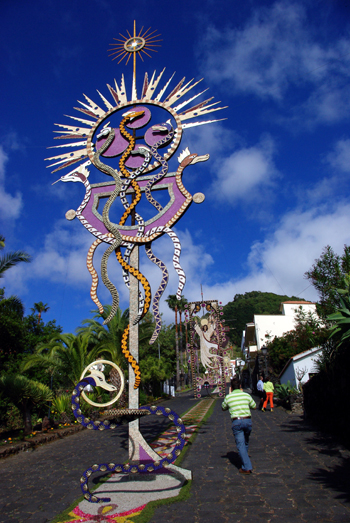
Mazo in La Palma is one of the best places to see Corpus Christi. Of course, Catholics all over the world celebrate the fiesta, but in Mazo they make the most wonderful archways and carpets decorated with petals, leaves and seeds.

The main feast day is ten weeks after Maundy Thursday, so this year it was on the 11th of June. If you’re impressed enough to book a holiday to see next year’s Corpus Christi, it’ll be on June 7th.
| 2012 | 7 June |
| 2013 | 30 May |
| 2014 | 19 June |
| 2015 | 4 June |
| 2016 | 26 May |
| 2017 | 15 June |
| 2018 | 31 May |
| 2019 | 20 June |
| 2020 | 11 June |
Each village of the municipality makes an archway with a carpet and a little altar. People collect the materials and work on intensively the pieces a couple of weeks in advance. Then the archways go up overnight from Wednesday to Thursday, and stay up until Sunday. The carpets beneath the archways are made using things rather like wrought iron gates, as stencils. They lay the “gate” down on the sand, fill the sections with petals or whatever, squirt with water-with-a-bit-of-glue-in-it, and lift the gate up again.
It’s difficult to overstate the work that goes into this. For example, how long do you think it would take you to do make of these?
And there are 25 of these rosettes across the base of the archway.
And the whole thing is maybe 10 metres (33 ft) high.
During a normal Catholic mass, the host is put into a special vessel called a monstrance. On Sunday they’ll hold a special mass in the church followed by a procession around the archways.
The priest walks on the carpets holding the blessed wafers in their special container (called a monstrance) while everyone else walks at the sides. As he comes to each archway, he puts the monstrance on the little altar, kneels and wafts incense around.
The church of San Blas, at the bottom of the hill, gets decorated too. It’s a rather unusual church in that it has three naves.

And the flowers inside are wonderful. If you get there, check out the ceiling over the altar, too.

If you miss this, you can see some examples from previous years in the Red House Museum.
